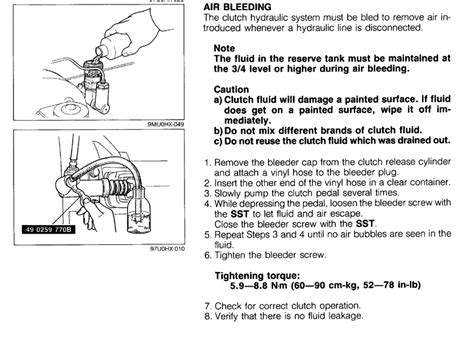Fix Your Slipping Clutch: A Master Cylinder Bleeding Guide
A slipping clutch can be a frustrating and potentially dangerous problem. Before you start throwing parts at your car, understanding the root cause is crucial. Often, a slipping clutch is related to a lack of hydraulic pressure in the clutch system, which can be solved by bleeding the master cylinder. This comprehensive guide will walk you through the process of bleeding your clutch master cylinder, helping you diagnose the problem and regain control of your vehicle.
What Causes a Slipping Clutch?
Before we dive into bleeding the master cylinder, let's quickly address the root causes of a slipping clutch. While a low fluid level and air in the hydraulic lines are common culprits addressed by bleeding, other issues can also cause clutch slippage:
- Worn Clutch Disc: This is the most common cause of clutch slippage. The friction material on the clutch disc wears down over time, reducing its ability to grip the flywheel.
- Leaking Slave Cylinder: A leak in the slave cylinder prevents the clutch from engaging properly.
- Hydraulic System Issues: Air in the hydraulic lines, a low fluid level, or a faulty master cylinder can all lead to a slipping clutch. This is where bleeding comes in.
- Damaged Pressure Plate: A damaged or worn pressure plate may not apply sufficient pressure to the clutch disc.
How to Tell if Your Clutch Master Cylinder Needs Bleeding?
Several symptoms indicate air might be in your clutch hydraulic system, requiring a bleed:
- Slipping Clutch: The most obvious symptom – the clutch pedal feels soft and the engine revs without the car moving forward smoothly.
- Spongy Clutch Pedal: The clutch pedal feels soft and mushy, not firm.
- High Clutch Pedal: The clutch pedal is higher than usual.
- Clutch Pedal Goes to the Floor: The pedal drops completely to the floor.
If you're experiencing these issues, proceed with caution and ensure you have the necessary tools and knowledge before attempting to bleed the system.
What You'll Need to Bleed Your Clutch Master Cylinder
Before you begin, gather these essential tools:
- Clutch Bleeder Kit: This usually includes a clear tube, a wrench to fit the bleeder screw, and a container to collect the fluid.
- New Clutch Fluid: Use the type specified in your vehicle's owner's manual. DOT 3 or DOT 4 are common.
- Wrench: To access the bleeder screw on the slave cylinder.
- Gloves: To protect your hands from the brake fluid.
- Rags or Shop Towels: To clean up any spills.
- Vehicle Owner's Manual: To locate the bleeder screw and understand your vehicle's specifications.
How to Bleed Your Clutch Master Cylinder: A Step-by-Step Guide
This process may vary slightly depending on your vehicle's make and model. Always refer to your owner's manual for specific instructions.
- Locate the Bleeder Screw: Consult your owner's manual to find the clutch slave cylinder bleeder screw. It's usually located on the slave cylinder itself, near the transmission.
- Open the Bleeder Screw: Using the appropriate wrench, slightly open the bleeder screw.
- Attach the Bleeder Kit: Attach one end of the clear tube to the bleeder screw and submerge the other end in a container filled with fluid.
- Pump the Clutch Pedal: Have an assistant pump the clutch pedal several times. Each pump should push fluid and air bubbles through the line and into the container.
- Monitor the Fluid: Watch the clear tube for air bubbles. Continue pumping until no more bubbles appear.
- Tighten the Bleeder Screw: Once the fluid runs clear, tighten the bleeder screw firmly.
- Check the Clutch Fluid Reservoir: Check the master cylinder fluid reservoir and top it off with fresh fluid as needed.
- Test the Clutch: Start the car and test the clutch pedal. It should feel firm and responsive.
What if Bleeding Doesn't Fix the Slipping Clutch?
If bleeding the clutch master cylinder doesn't resolve the slipping clutch issue, the problem may lie elsewhere. It’s time to consider these possibilities:
- Worn Clutch Disc: The clutch disc might be worn out and require replacement.
- Faulty Slave Cylinder: The slave cylinder may be leaking or malfunctioning.
- Damaged Pressure Plate: The pressure plate might be damaged or worn.
In these cases, professional assistance is likely required. A mechanic can diagnose the problem accurately and perform the necessary repairs.
Conclusion
Bleeding the clutch master cylinder is a relatively straightforward process that can resolve a slipping clutch caused by air in the hydraulic lines. However, remember to always prioritize safety and consult your vehicle's owner's manual for specific instructions. If bleeding doesn't solve the problem, seek professional help to avoid further damage to your vehicle. Remember, regular maintenance, including checking clutch fluid levels, can help prevent these issues in the future.

